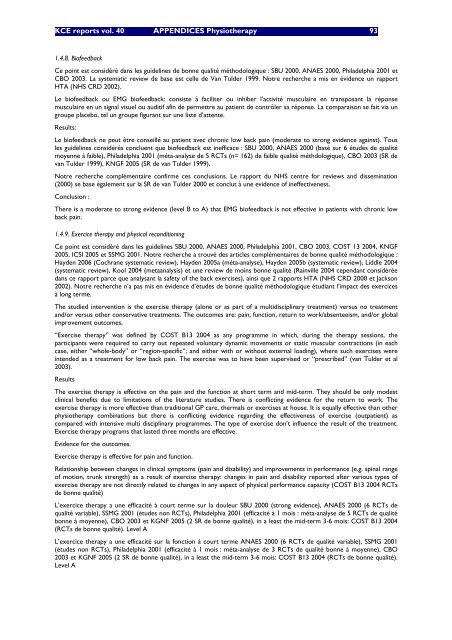Download the supplement (208 p.) - KCE
Download the supplement (208 p.) - KCE
Download the supplement (208 p.) - KCE
You also want an ePaper? Increase the reach of your titles
YUMPU automatically turns print PDFs into web optimized ePapers that Google loves.
<strong>KCE</strong> reports vol. 40 APPENDICES Physio<strong>the</strong>rapy 93<br />
1.4.8. Biofeedback<br />
Ce point est considéré dans les guidelines de bonne qualité méthodologique : SBU 2000, ANAES 2000, Philadelphia 2001 et<br />
CBO 2003. La systematic review de base est celle de Van Tulder 1999. Notre recherche a mis en évidence un rapport<br />
HTA (NHS CRD 2002).<br />
Le biofeedback ou EMG biofeedback: consiste à faciliter ou inhiber l activité musculaire en transposant la réponse<br />
musculaire en un signal visuel ou auditif afin de permettre au patient de contrôler sa réponse. La comparaison se fait via un<br />
groupe placebo, tel un groupe figurant sur une liste d attente.<br />
Results:<br />
Le biofeedback ne peut être conseillé au patient avec chronic low back pain (moderate to strong evidence against). Tous<br />
les guidelines considérés concluent que biofeedback est inefficace : SBU 2000, ANAES 2000 (basé sur 6 études de qualité<br />
moyenne à faible), Philadelphia 2001 (méta-analyse de 5 RCTs (n= 162) de faible qualité méthdologique), CBO 2003 (SR de<br />
van Tulder 1999), KNGF 2005 (SR de van Tulder 1999).<br />
Notre recherche complémentaire confirme ces conclusions. Le rapport du NHS centre for reviews and dissemination<br />
(2000) se base également sur la SR de van Tulder 2000 et conclut à une evidence of ineffectiveness.<br />
Conclusion :<br />
There is a moderate to strong evidence (level B to A) that EMG biofeedback is not effective in patients with chronic low<br />
back pain.<br />
1.4.9. Exercice <strong>the</strong>rapy and physical reconditioning<br />
Ce point est considéré dans les guidelines SBU 2000, ANAES 2000, Philadelphia 2001, CBO 2003, COST 13 2004, KNGF<br />
2005, ICSI 2005 et SSMG 2001. Notre recherche a trouvé des articles complémentaires de bonne qualité méthodologique :<br />
Hayden 2006 (Cochrane systematic review), Hayden 2005a (méta-analyse), Hayden 2005b (systematic review), Liddle 2004<br />
(systematic review), Kool 2004 (metaanalysis) et une review de moins bonne qualité (Rainville 2004 cependant considérée<br />
dans ce rapport parce que analysant la safety of <strong>the</strong> back exercises), ainsi que 2 rapports HTA (NHS CRD 2000 et Jackson<br />
2002). Notre recherche n a pas mis en évidence d études de bonne qualité méthodologique étudiant l impact des exercices<br />
à long terme.<br />
The studied intervention is <strong>the</strong> exercise <strong>the</strong>rapy (alone or as part of a multidisciplinary treatment) versus no treatment<br />
and/or versus o<strong>the</strong>r conservative treatments. The outcomes are: pain, function, return to work/absenteeism, and/or global<br />
improvement outcomes.<br />
Exercise <strong>the</strong>rapy was defined by COST B13 2004 as any programme in which, during <strong>the</strong> <strong>the</strong>rapy sessions, <strong>the</strong><br />
participants were required to carry out repeated voluntary dynamic movements or static muscular contractions (in each<br />
case, ei<strong>the</strong>r whole-body or region-specific ; and ei<strong>the</strong>r with or without external loading), where such exercises were<br />
intended as a treatment for low back pain. The exercise was to have been supervised or prescribed (van Tulder et al<br />
2003).<br />
Results<br />
The exercise <strong>the</strong>rapy is effective on <strong>the</strong> pain and <strong>the</strong> function at short term and mid-term. They should be only modest<br />
clinical benefits due to limitations of <strong>the</strong> literature studies. There is conflicting evidence for <strong>the</strong> return to work. The<br />
exercise <strong>the</strong>rapy is more effective than traditional GP care, <strong>the</strong>rmals or exercises at house. It is equally effective than o<strong>the</strong>r<br />
physio<strong>the</strong>rapy combinations but <strong>the</strong>re is conflicting evidence regarding <strong>the</strong> effectiveness of exercise (outpatient) as<br />
compared with intensive multi disciplinary programmes. The type of exercise don t influence <strong>the</strong> result of <strong>the</strong> treatment.<br />
Exercise <strong>the</strong>rapy programs that lasted three months are effective.<br />
Evidence for <strong>the</strong> outcomes.<br />
Exercise <strong>the</strong>rapy is effective for pain and function.<br />
Relationship between changes in clinical symptoms (pain and disability) and improvements in performance (e.g. spinal range<br />
of motion, trunk strength) as a result of exercise <strong>the</strong>rapy: changes in pain and disability reported after various types of<br />
exercise <strong>the</strong>rapy are not directly related to changes in any aspect of physical performance capacity (COST B13 2004 RCTs<br />
de bonne qualité)<br />
L exercice <strong>the</strong>rapy a une efficacité à court terme sur la douleur SBU 2000 (strong evidence), ANAES 2000 (6 RCTs de<br />
qualité variable), SSMG 2001 (études non RCTs), Philadelphia 2001 (efficacité à 1 mois : méta-analyse de 5 RCTs de qualité<br />
bonne à moyenne), CBO 2003 et KGNF 2005 (2 SR de bonne qualité), in a least <strong>the</strong> mid-term 3-6 mois: COST B13 2004<br />
(RCTs de bonne qualité). Level A<br />
L exercice <strong>the</strong>rapy a une efficacité sur la fonction à court terme ANAES 2000 (6 RCTs de qualité variable), SSMG 2001<br />
(études non RCTs), Philadelphia 2001 (efficacité à 1 mois : méta-analyse de 3 RCTs de qualité bonne à moyenne), CBO<br />
2003 et KGNF 2005 (2 SR de bonne qualité), in a least <strong>the</strong> mid-term 3-6 mois: COST B13 2004 (RCTs de bonne qualité).<br />
Level A
















